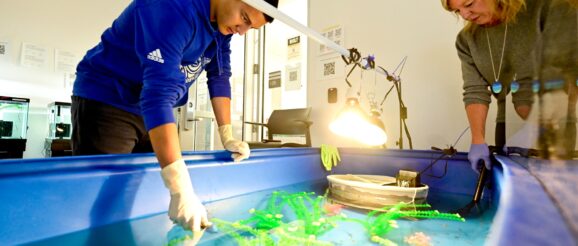SVVSD Innovation Center students take on leopard frog conservation project

Students in a conservation data science class at St. Vrain Valley’s Innovation Center are working to shepherd about 400 northern leopard frog tadpoles to maturity so they can be released in the wild with a higher chance for survival.
Their goal is to release the tadpoles when they’re past the high mortality rates of their early stages but before they complete the transformation into frogs. A fungus and a virus, both carried by invasive bullfrogs, are the main culprits of the early die-offs, the students said.
“They’re very fragile with very thin skin that absorbs everything,” said Avan Richmond, a sophomore at Silver Creek High School. “More tadpoles are dying in the wild than the species can reproduce.”
In Colorado, northern leopard frogs are listed as a “Tier 1 Species of Greatest Conservation Need.”

The leopard frog project replaces a previous multi-year project at the Innovation Center that centered on reintroducing the northern redbelly dace fish to the St. Vrain River. The fish and leopard frog projects share many of the same partners, including Boulder County Parks and Open Space, Colorado Parks and Wildlife, the Denver Zoo and the Ocean First Institute.
Mikki McComb-Kobza, the executive director of Ocean First Institute, and Mac Kobza, a wildlife biologist with Boulder County Parks and Open Space, also have mentored students through both projects.
“This is our pilot year with the frogs,” McComb-Kobza said. “We are learning a lot.”
Jayme Margolin-Sneider, the Innovation Center’s bioscience pathway manager, said the decision was made to switch to frogs because raising the fish was so time intensive. The fish had to be fed and tanks cleaned twice a day year round, including on weekends and through the summer.
An automatic feeder takes care of weekend feedings for the tadpoles, while a live camera allows for remote check-ins. During the school week, students run daily water quality tests, feed the tadpoles and clean the tank. A ruler on the bottom of the tank serves as a non-invasive way to take measurements as they grow.
While the time commitment is a little lower, Margolin-Sneider said, students are learning just as much about science and conservation.
“They get a good glimpse of what it’s like to work on this as a career,” she said. “The students are learning how to troubleshoot and collaborate. It’s real life skills. They have worked so hard.”

The students began working on the frog project in January, including researching, taking field trips and designing the frog hatching set up. On April 14, Boulder Open Space and Mountain Parks provided two egg masses that were collected from an open space pond.
While the students were expecting around 300 eggs, they ended up with around 4,000 — well above the number their tanks could accommodate. So after the eggs hatched, most of the tadpoles were released back into the wild. The remaining 420 tadpoles won’t be released until they start developing limbs.
The students took a field trip to the Denver Zoo to learn about the best options for feeding tadpoles, which includes algae wafers and bloodworms. A student team also built a vertical hydroponics system to grow leafy greens for feeding, as well as building a hammock to hold the eggs until they hatched and designing the light system.
“We have put so much work into the process,” said Emma Quesada, a junior at Niwot High School. “It’s been a lot of ‘How do we fix all the problems?’ It has been really cool to see it work out so well.”
The students are continuing to build on what was learned through the redbelly dace project, including working with environmental DNA. By testing water samples for DNA, students have checked for the presence of the dace after releases and plan to use the same methods to test for the presence of the frogs.
Along with contributing to frog conservation efforts, students are using their work on the project to enter contests.
Groups have won second, third and fourth place in the RISE Challenge Colorado.
A three-student group also entered Philippe Cousteau’s EarthEcho International challenge. The “Fungi Frogs” team — composed of Erie High freshman Blake Wolver; Niwot High sophomore Trevor White; and Margolin-Sneider’s sixth-grade son, Reed Sneider — is a finalist in the contest, which includes U.S. and U.K. teams.
Their group focused on biosecurity for the tanks and field work. Their goal was a tadpole mortality rate of less than 5%. Though three of the eggs failed to develop into tadpoles, their tadpole mortality rate, so far, is zero.
“We want to get them past all these bottlenecks to where they’re more likely to survive in the wild,” White said.
